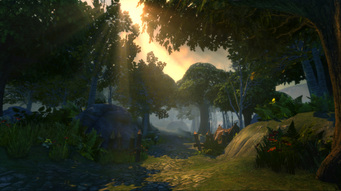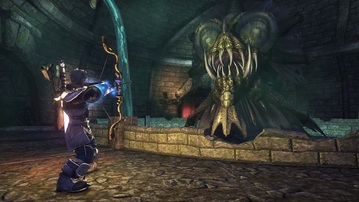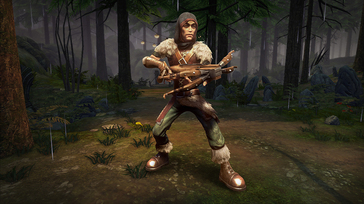
Back in 2004, Fable gave a surprising and interesting take on the fantasy genre. It was often inventive. But never innovative. It was clumsily made in fact with a strict targeting system, clunky gameplay and an even more dire control scheme, as well as splurging a rather uncreative storyline when compared to other fantasy RPG’s. Anyone who has ever played a fantasy game knows that complex stories can be mesmerising when done properly (Dragon Age: Origins anyone?), but Fable never once attempted it within its own narrative. Fable’s story felt safe with very little risk taken on behalf of the characters or in-game events, but in its own way, this was fine. This was just Fable. It was just how Fable was.

The main appeal of Fable was also the game’s amazing amount of customisation where you could choose from a varied library of medieval clothing styles, mix-matching for the style that suited you. This feature on its own enhanced the player’s personal connection to his or her character, and it was something which Lionhead Studios built on wonderfully in the sequels. However because Fable was opened up to that wider audience, many of these people misinterpreted Fable’s presentation of these ideas, which included a choice system and a gauge of Good and Evil, as actual gaming innovation (having probably not played many games in the same genre before).
Again, it didn’t matter at the time. What mattered was that the game was fun. And it was fun, so we loved it. So ten years later, the newest developers at Lionhead Studios have followed in the footsteps of 343 Studios and Nintendo by releasing an HD release of one of their studio’s most beloved games. Unfortunately however (and it pains me to say it). but upon release Fable Anniversary had more bads than goods.

The major selling point for Fable Anniversary was the updated visuals, so let’s start here. I find it terribly ironic that some of this game’s major flaws were connected to the new graphics. It’s no secret that the team over at Lionhead Studios had worked for the entirety of the previous year rebuilding Albion’s medieval era in beautiful , fluorescent HD.
However, their fidelity to recreating the graphical style of the original also captured all of the same glitches as they appeared in the original 2004 Fable, and the frame-rate of Fable Anniversary was clunky and unpolished from the offset (Oakvale looked moments away having an earthquake in the opening missions). This seemed to straighten itself out however as you progressed through the game, but was notable throughout the opening chapter. It was clear just to what length the developers had gone to in their recreation of Albion once your hero character finally breaks free of the Heroes' Guild. Albion looked bigger than before. One of the criticisms I had with the original was that the sprawling wilderness of Albion was anything but, which was something they had truly managed to correct with Fable 2 and then disappointingly stumble back into with Fable 3.
The woods and forests of Fable Anniversary have been broadened out, making everything appear bigger and wider much like in Fable 2. The scenic landscapes looked good although are hardly groundbreaking, and the world recaptured the cocky British atmosphere well enough. One of the unique things about the whole Fable franchise is its quirky British sense of humour, which made its welcome return in Fable Anniversary. This is expanded on a little too with the addition of the new achievements, which feature a varied and hilarious array of geek-culture references (including Assassin’s Creed, Bioshock Infinite and even Game of Thrones).

Not every part of this anniversary rebuild came out of the creative process clean however.
The gorgeous landscapes were irked somewhat by the awful weather effects, such as the lightning of Witchwood, which did not resemble lightning at all. The opposite, in fact. The world seemed to be lit up all of the time and when lightning ‘flashes’ the world fell dark instead, with only a cackle of thunder to let you know what is happening. I thought my TV had broken at first. It was the reverse of lightning, and therefore distracting.
The majority of character models of Fable Anniversary are actually surprisingly terrible. The same character designs from the original Fable return with a new coat of paint, meaning that all of the characters have burnt-out leathery skin and overly wide features. You can paint a turd gold but underneath the gold it's still a turd, Lionhead. It's shaped like a turd and no amount of gold paint will change that. What you needed to do was recreate each model from scratch, just like Nintendo with the character models of Ocarina of Time 3D, which was truly an updated and enhanced version of a classic.

The game’s cut-scenes were also directed as if they were still playing on the original Xbox, with little to no improvement on their original animations and a startling lack of physical of facial movement. The eyes of each character model are hard and soulless, like something out of Beowulf, which is disappointing, kind of creepy and quite utterly bewildering. Technology in terms of producing high-quality graphics, as well as intricate animations for them, has come a long way in the last decade and the fact that Lionhead chose specifically not to embrace this actually boggles the mind as a loyal fan of this series. Rebuilding Fable in HD from the ground up should have meant utilising all of the things they learned from the visuals of Fable 2 and 3, but these advancements were – irksomely – ignored during the year-long development process. Even rebuilding Fable using the Fable 3 engine would have offered a superior visual style. Since the developers did have half-assed job with the actual graphics, focusing only on the regions and not really on the characters, let’s move onto the gameplay of Fable Anniversary. Perhaps it is here where we will find the gems in this mixed cave of diamond and coal.

The regions themselves are small even when compared to those in Fable 2 so why they are separated by these sluggish, pace-breaking gaps is utterly, utterly mystifying. For such a fast-moving storyline these loading times add nothing and slow the pacing right down. Their inclusion comes across as sloppy and just generally lazy.
It was particularly annoying when the game crashed upon my return to Oakvale although this only happened once. I was never paranoid that my game would crash every five minutes like with Batman: Arkham Origins. The most vexing of all takes place between the Heroes Guild and the Chamber of Fate, where the game has to load up a miniscule bridge connecting the two areas, before then – separately – loading up the actual Chamber of Fate. I recalled that this was present in the original game too, and should have been removed during the rebuild.
Since the loading times are still a problem ten years on, maybe the combat system had been improved? The developers offer the player a choice to play by the game-play style of the original Fable or its two sequels, where the system was much improved upon. Of course I chose the latter (although to be fair it was the default setting before I investigated). You can imagine my displeasure when this only focused on the control scheme, and not the smoothness of the combat as was perfected in Fable 2 and 3. No matter what option you settled for the combat in this game was as inflexible and dawdling as it always was back in 2004. It was old fashioned and terribly, terribly dated.

Fable Anniversary did get more enjoyable as you pushed on with it, and even let you get used to its flaws after a time, but they never disappeared. You either had to live with them or not play at all. That said, should you wish to ignore them and continue playing – the actual playtime of the game itself is very decent. At nine hours in I was touching on just midway through the game’s story, bearing in mind that Fable Anniversary includes all of the new side-quests included in Fable: The Lost Chapters.
So let’s wrap this up because I need to drown my sorrows.
Considering that the idea to update Fable in HD came from the success of Halo: Combat Evolved Anniversary you’d have thought that – like 343 Studios did with that title – Lionhead would have adopted the same sort of creativity they had, by completely remaking the whole thing.

This is where you could argue that Halo was much easier to do, and I suppose it was. As a straightforward FPS, games similar to Halo are still popular today. RPG’s however, as I said earlier, have come a long way. You could also argue that since Fable is an RPG then it should be cut some slack as more classical RPG’s are much harder to reintroduce as modern titles in this generation.
But it simply is not true. You need only look to Nintendo’s latest incarnation of The Legend of Zelda: The Wind Waker for proof of that. The differences between Fable and Zelda have always been staggering of course, but things were changed. Mechanics were discarded and new ones were added. More was done. Although it was certainly an interesting experiment, Fable Anniversary probably did not have all of the right ingredients to begin with. Perhaps with a fresh direction and perspective it could have worked out better, such as was the case with Metal Gear Solid: The Twin Snakes (which was a remake of the original PlayStation game and exclusive to the Nintendo Gamecube). In that game, like with Halo, mechanics introduced in the later games were added in order to modernise it. The game’s cut-scenes were also completely redone to make it all much more cinematic.
So overall?
Fable was a product of its time and one of the only things Fable Anniversary proved is that the game does not translate well enough from that generation to this one. A true anniversary would have utilised more creativity and learned from the processes attempted in the sequels. The game was playable and as fun as it was ten years ago, which is depressing as Hell.

 RSS Feed
RSS Feed
